Postnatal recovery: advice and exercise
Physiotherapy advice for women and birthing people after pregnancy
This leaflet provides information, advice, and safe exercises for you after your pregnancy. These exercises will help your body recover safely and effectively. After pregnancy, it is important to allow your body time to adjust.
Although you cannot expect to return to full pre-pregnancy fitness immediately, there is a lot you can do now to help:
strengthen your body
regain your fitness; and
increase your energy levels.
During pregnancy your body will have gone through a lot of changes that affect your muscles, joints, and posture. It is important to increase your physical activity level in the right way, in order to achieve your goals as quickly and comfortably as possible.
It is important to:
Listen to your body
Stop if it hurts
Stop when tired
Never exercise if you feel unwell
Exercise as consistently as you are able
Progress your exercise / activity levels as you improve.
Slow down or stop exercising if you experience any of the following symptoms
Increased fatigue (tiredness).
Heavy vagina (your vagina feels like it is pulling down / feels heavy).
Feeling of ‘pushing down’ (pressure or heavy feeling in your groin / vagina).
Muscle aches and pains, that do not stop after resting.
Colour changes in lochia (discharge after pregnancy); the lochia becomes pink or red again.
Heavier than normal lochia flow.
Lochia starts flowing again after it has stopped.
Swollen abdomen (tummy).
Pain around your caesarean scar (if you have one).
Signs of infection around your caesarean scar (if you have one). Symptoms include, weeping / pus from the wound, redness, swelling, wound gaping, and / or pain.
If you are unsure about any of the symptoms, please ask your midwife, GP, or physiotherapist for advice.
If you experienced pelvic girdle pain during your pregnancy
You may need to build your activity levels up more slowly.
You may find certain exercises painful. If so, leave these exercises out and continue with the exercises that are comfortable for you.
If you find that ongoing pain is limiting your recovery, ask your GP for a physiotherapy referral.
Going to the toilet
Make sure that you sit down properly on the toilet. If you hover over the toilet seat your bladder may not empty properly.
Take your time and try to relax.
It is important to drink normally (1.5 to 2 litres per day). Drinking water is best. This will help your bladder and bowels to work well.
You should pass urine every 3 to 4 hours throughout the day. Avoid going to the toilet to pass urine ‘just in case’.
Moving my bowels (having a poo)
It is important to avoid constipation. Constipation is not pooing as often, or finding it hard to poo. This can put extra pressure on your pelvic floor muscles and operation site, if you had:
a caesarean; or
stitching after an episiotomy or perineal tear.
Eating plenty of fruit, vegetables, and fibre can help. Also, make sure that you are drinking enough fluids.
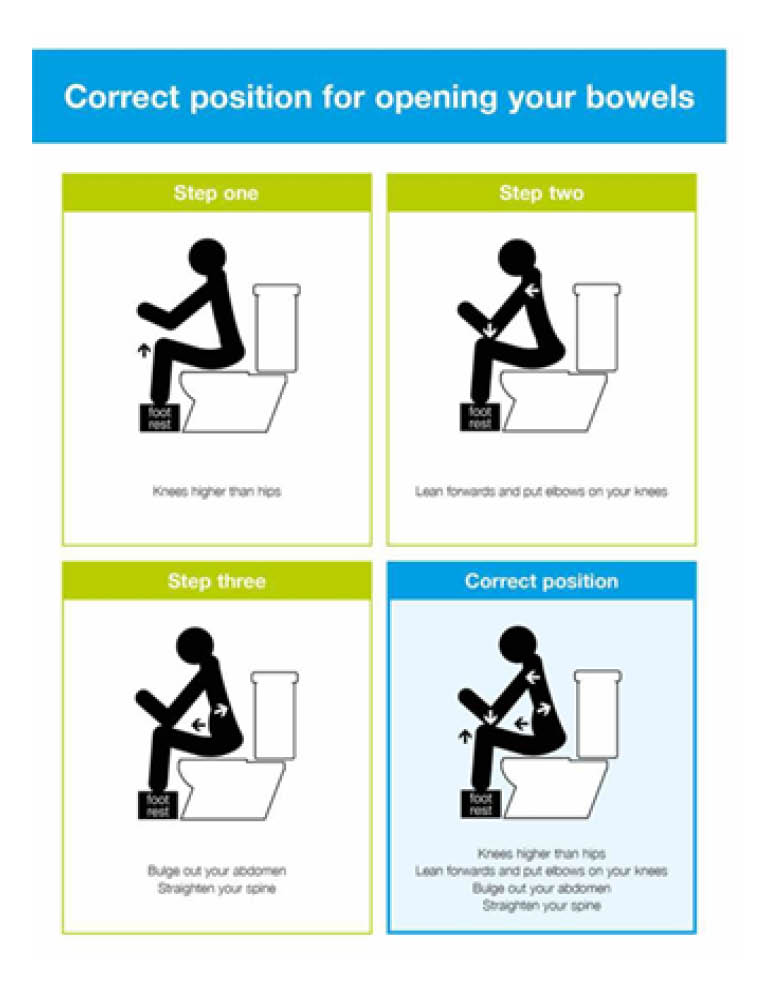
Do not strain.
Sit fully on the toilet seat: do not ‘hover’.
Have your feet apart and raised up on a stool / support. Rest your arms comfortably on your thighs.
Keep your tummy relaxed; do not tighten your abdominal (tummy) muscles.
Avoid holding your breath; try to have a relaxed breathing pattern.
Some women / birthing people may find it helpful to support their perineum. You can do this by applying some pressure with your hand with a clean sanitary pad or toilet paper. The perineum is the area between your back passage and vagina.
If you feel constipated or the need to strain when passing a bowel motion, talk to your GP about medications which may help with this.
Activities to do in the first few days
Within the first few hours after birth, whenever you feel ready, you can begin breathing exercises.
Breathing exercises
Whilst you are less active than normal, it is important to practice regular breathing exercises. This helps to prevent chest infections.
Take a deep slow breath in through your nose, letting your tummy relax and rise.
Hold for a count of two, and sigh the air out through your mouth.
Repeat 3 times.
Do this regularly through the day, until you are up and about as usual.
You can combine these with pelvic floor exercises, engaging these muscles as you breathe out. If you have had a caesarean birth you will need to wait until your catheter has been removed first.
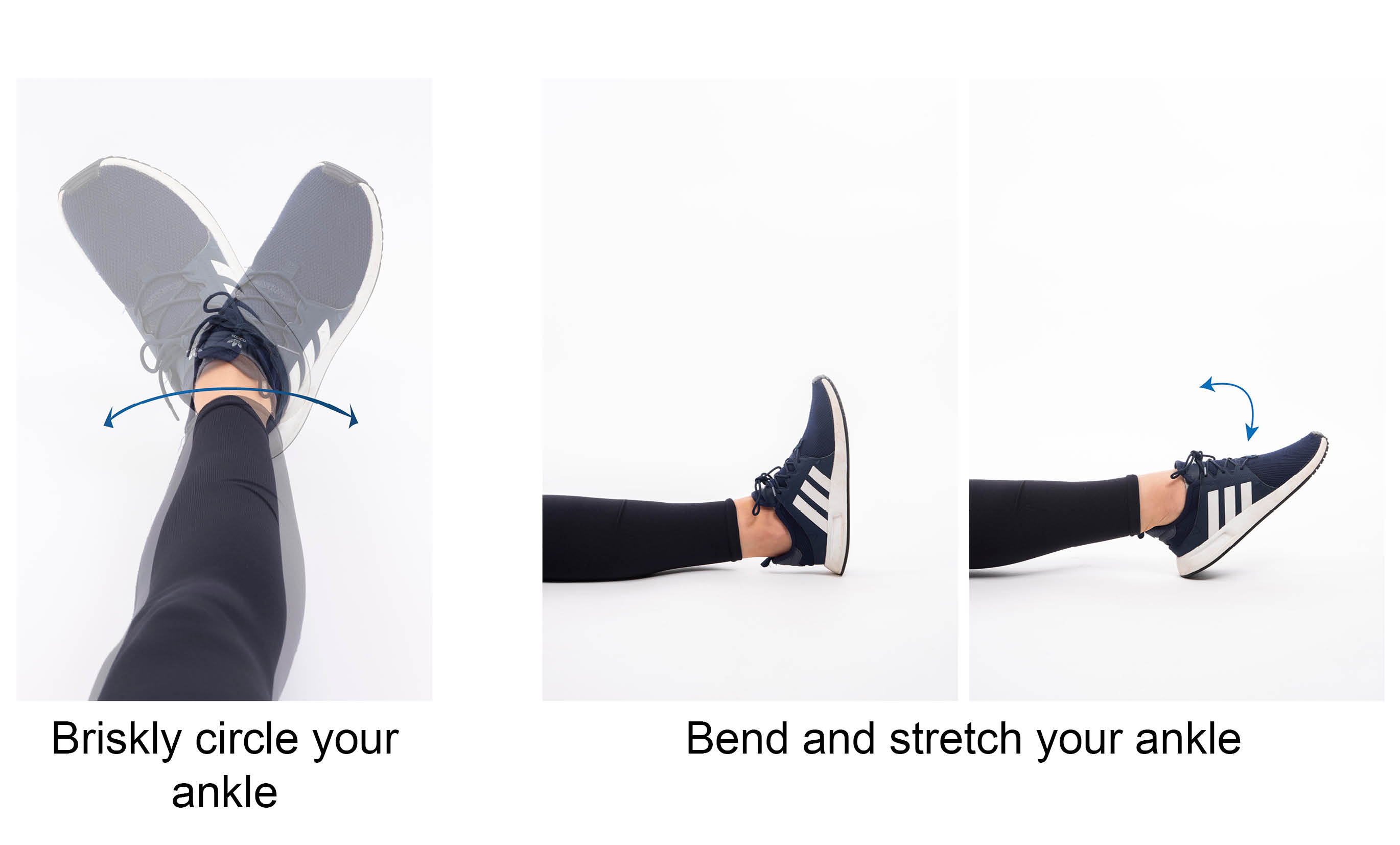
Circulation exercises
Briskly circle, then bend and stretch your ankles for 20 to 30 seconds. This helps your circulation, and prevents and reduces swelling in your legs and ankles.
Start this exercise immediately, to reduce a build up of fluid in your legs and ankles. Continue until you are up and about.
Repeat approximately 5 times throughout the day.
Posture (your body’s position when sitting, standing, or lying down)
It is important to be aware of your posture throughout the day. This will help to minimise joint stiffness, and muscle aches and pains. Below are some helpful tips to try.
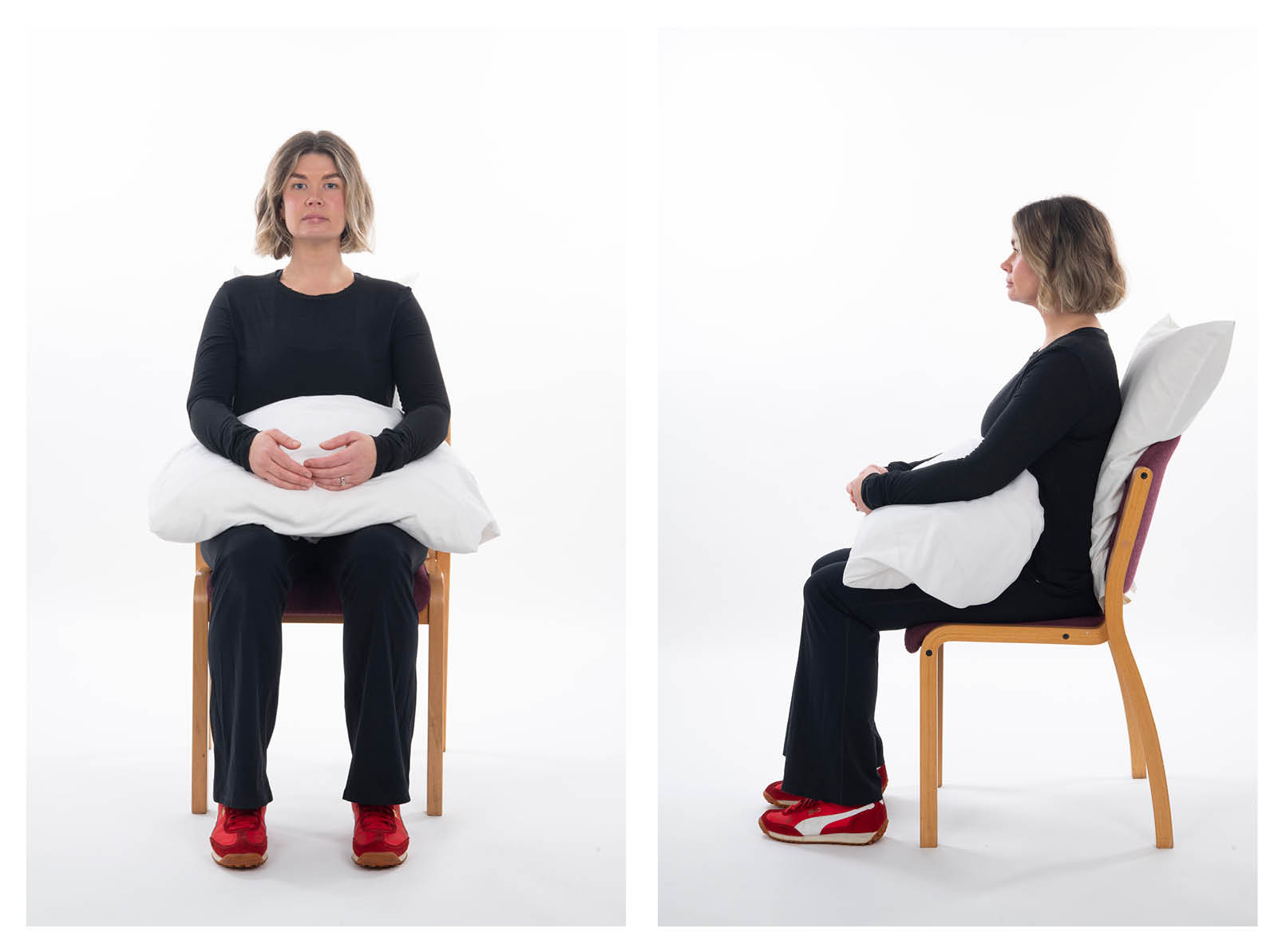
When sitting, place a small pillow behind your lower back to support you.
When standing, try to avoid leaning forwards. Sit or kneel if you are able to, so that tables are at waist height. If this is not possible, take regular breaks.
Have a pillow under your arms when sat reading or using a tablet or phone. This will help to reduce the strain on your shoulders and back.
.png)
When lifting, keep the weight close to your body to ease the strain on your back.
Try to use your tummy muscles and pelvic floor before lifting or carrying something. This will help to avoid back aches and pains.
When sitting down or standing up from a chair or bed, support your abdomen (tummy) with one hand.
When getting up from bed, roll onto your side, swing your legs over the edge and push yourself up slowly. Try to avoid sitting up straight from lying.
What are pelvic floor muscles?
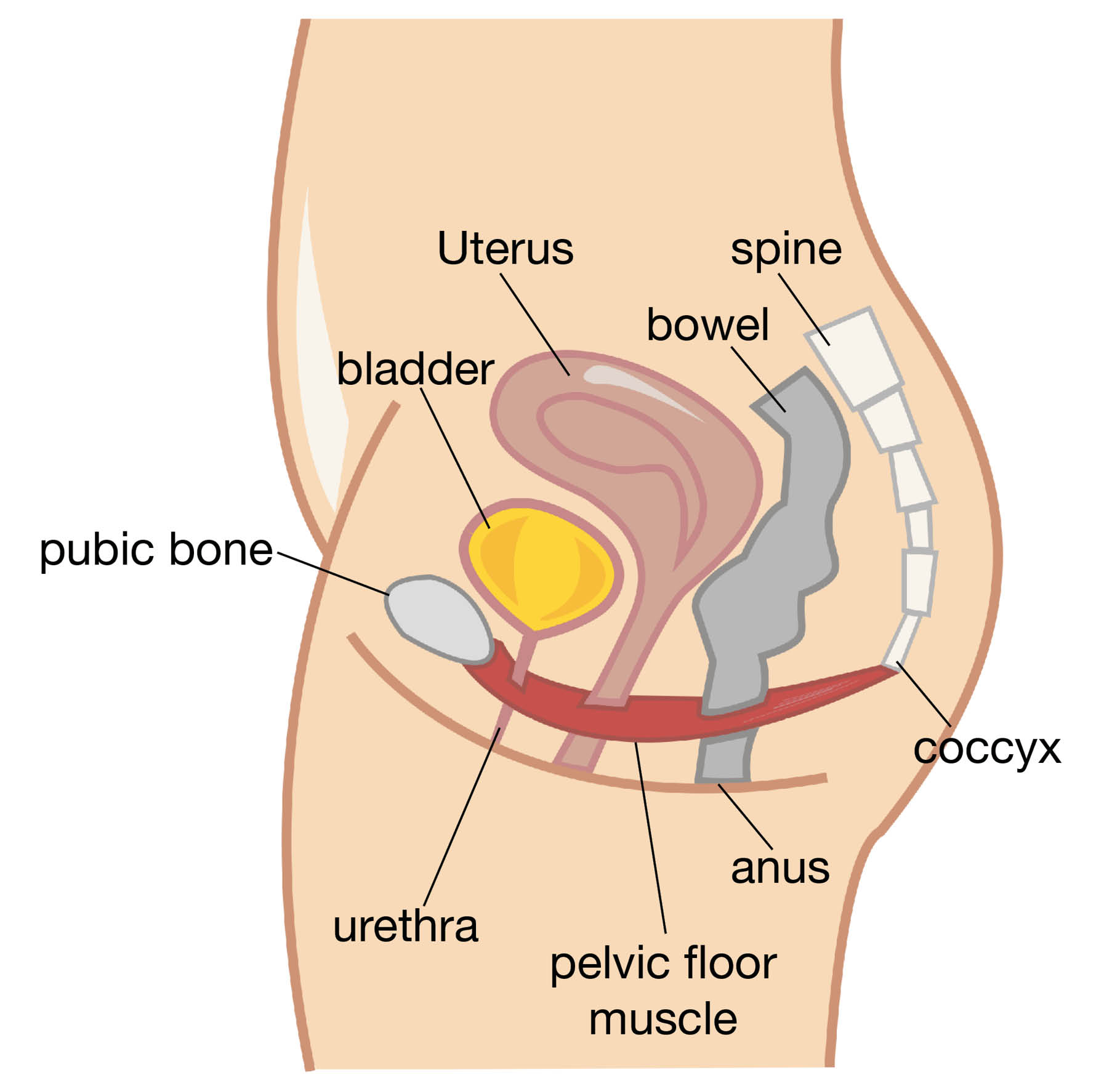
Your pelvic floor muscles are a group of muscles that you use when you need to control your bladder or bowels. They help to:
stabilise your pelvis
support the organs within your abdomen; and
they play an important role in your sex life.
Your pelvic floor attaches from your coccyx (at the bottom of your spine) to your pubic bone (at the front of your pelvis), like a sling.
Why are pelvic floor exercises important?
During pregnancy, hormonal changes can cause your pelvic floor muscles to weaken. The extra weight you carry means these muscles need to work harder.
After giving birth, it is important to strengthen your pelvic floor. This will help these muscles to heal. It is even more important if you have damage to your perineum from a tear or an episiotomy.
It is important to strengthen the pelvic floor, just like we would with any other muscle. Strengthening these muscles will prevent problems such as:
incontinence (not being able to control urine, wind, and / or poo); and
prolapse (when one or more of the organs in the pelvis slip down from their normal position and bulge into the vagina).
How do I do pelvic floor exercises?
Hopefully you have already been practicing your pelvic floor exercises, as advised by your midwife during pregnancy.
It is good to resume these exercises as soon as possible after pregnancy. If you have a catheter, wait until it is removed before exercising.
Your pelvic floor muscles will not be very strong straight after giving birth. It is important to strengthen these muscles as soon as possible. For more information, please go to the My Health London YouTube channel. Here you can watch a series of short videos showing you:
how to do pelvic floor exercises
how to manage your pain; and
how to care for your wound.
Sit comfortably in an upright position, with your feet and knees wide apart. If preferred, you can also lie down flat (supine position) with your legs slightly apart.
Keep breathing throughout. Keep your stomach, leg, and buttock muscles relaxed.
Breathe in and let your tummy relax and rise.
As you breathe out, imagine that you are trying to stop yourself from passing gas from your bowel. At the same time also try to stop the flow of urine from your bladder. You should feel a lifting and tightening around your vagina and anus. Continue to keep breathing, and avoid holding your breath while you practice these exercises.
Looking at the muscles can be a useful way of checking they are working correctly. Lie propped on the bed; place a small mirror between your legs with your knees bent and apart. As you pull up the pelvic floor, you should see your anus and entrance to the vagina lifting and drawing in.
Note: If you notice the entrance to your vagina widening, you are pushing down and not pulling up. This is the opposite to tightening the pelvic floor muscle. Also, if you leak urine or pass gas when doing this exercise, it is likely you are pushing down and not pulling up.
How often should I practice my pelvic floor exercises?
First determine your ‘starting block’.
Tighten your pelvic floor muscles as much as you can. Do this without using your buttocks or thigh muscles, as described above. Hold tight for as many seconds as you can (up to a maximum of 10 seconds).
How long can you hold the maximal contraction? _____ seconds (for example 2 seconds).
Release the contraction. Rest for at least the same time as the contraction.
Repeat the ‘tighten, hold and release’ as many times as you can (up to a maximum of 8 to 12 times).
How many times can you repeat the contraction? _____ times (for example 4 times).
This is your ‘starting block.’ Repeat your starting block 4 to 6 times during the day.
As a result of this muscle training, your pelvic floor will get stronger. Your starting block will change, for example you will be able to hold for 4 seconds, and repeat 6 times. This becomes your new starting block.
This program builds up the endurance of the muscle group. In other words, your pelvic floor muscles will be able to work harder for longer.
Now perform the pelvic floor exercise, but squeeze quickly and let go. Do this up to 12 times.
How many times can you repeat the contraction? _____ times (for example 6 times).
This is your ‘starting block.’ Repeat your starting block 4 to 6 times during the day.
Rest 1 to 2 seconds before the next contractions. These are called quick contractions. They will help your muscles react quickly when you laugh, cough, exercise, or lift.
How many contractions can I do?
Aim to increase the number to 8 to 12 contractions, 3 times a day for at least 6 months. That’s the easy bit. The most difficult part of the program is remembering to do the exercises. Here are some tips to help trigger your memory.
Wear your watch on the wrong wrist.
Put stickers in places that will catch your eye. For example, your bathroom mirror, telephone, fridge, kettle, or steering wheel.
Exercise when feeding your baby.
Use reminders or alarms on your phone.
Download the squeezy app to set an exercise program and remind you to exercise.
It might also be helpful to practice ‘The Knack’ before a cough / sneeze / lifting. Tighten your pelvic floor muscles on purpose before a cough / sneeze / lifting something heavy.
We would advise you to continue these exercises throughout your life.
What if I am having problems with my pelvic floor exercises or muscles?
If you are struggling with your pelvic floor exercises after 6 to 8 weeks, speak to your GP. They can make a referral to the Pelvic Health Physiotherapy service. You can self-refer using the contact details on the Kent Community Health web page.
If you have any of the following symptoms after 8 to 12 weeks, speak to your GP. They can make a referral to the Pelvic Health Physiotherapy service. You can self-refer using the contact details on the Kent Community Health web page.
Heavy vagina (your vagina feels like it is pulling down / feels heavy).
Feeling of ‘pushing down’ (pressure or heavy feeling in your groin / vagina).
Leaking of urine (wee), faeces (poo), or wind which you are unable to control.
Needing to rush quickly to the toilet when you need to go; you are not able to wait.
One third of women experience pelvic floor problems, but this is not something that you should put up with. It is important to ask for help to improve these symptoms, and keep your pelvic floor working well.
Exercises to try next (up to about 6 weeks after giving birth)
If you had a caesarean birth, it will take you longer to progress through the next set of exercises. Remember to take it slowly, a caesarean section is a major operation. It will take you several weeks to recover. If you have any concerns about your recovery speak to your midwife, physiotherapist, or GP. More information is available on the NHS web site under Caesarean section: recovery.
You can also expect it to take a bit longer to build up to the next set of exercises if you had:
an instrumental birth (using forceps or ventouse); and / or
any injury to your pelvic floor (perineal tear or OASI)
Take your time, and bear in mind the signs to slow down at the beginning of this leaflet.
Everyone recovers / heals at a different rate. It is important to remember that if you try an exercise and it feels like too much, you should stop. If it is too much, continue with the general exercises above for a bit longer. If you are finding it difficult to move through these exercises talk to your midwife, physiotherapist, or GP.
Basic abdominal contractions
It is important after pregnancy to gently start strengthening your abdominal (tummy) muscles.
Before starting any of the gentle core exercises, make sure you have correctly practiced the basic abdominal contractions. This exercise is important to make sure you have the correct posture and technique before moving on to other strengthening exercises.
Only start this exercise when you feel comfortable. For some people this will be very soon, others may want to wait a bit longer.
Lie on your back with your knees bent and feet on the floor / bed. If this is not comfortable, lie on your side.
Tilt your pelvis forwards and backwards, as if flattening and then arching your back. After doing this 5 times, rest in a neutral position. A neutral position is roughly the middle point between lying your back fully flat and a fully arched back.
Find your hip bones at the front of your pelvis and move your fingers 1 inch down and 1 inch in. Your fingers will be over your deep abdominal muscles.
Breathe in and let your tummy rise. As you breathe out gently, draw your belly button in towards your spine. The muscles should tense slightly under your fingers. Do not worry if this does not happen first time, keep practicing.
You can now try practicing this exercise in different positions. Have a go at kneeling on all fours, standing, and sitting.
Repeat this exercise twice a day.
-
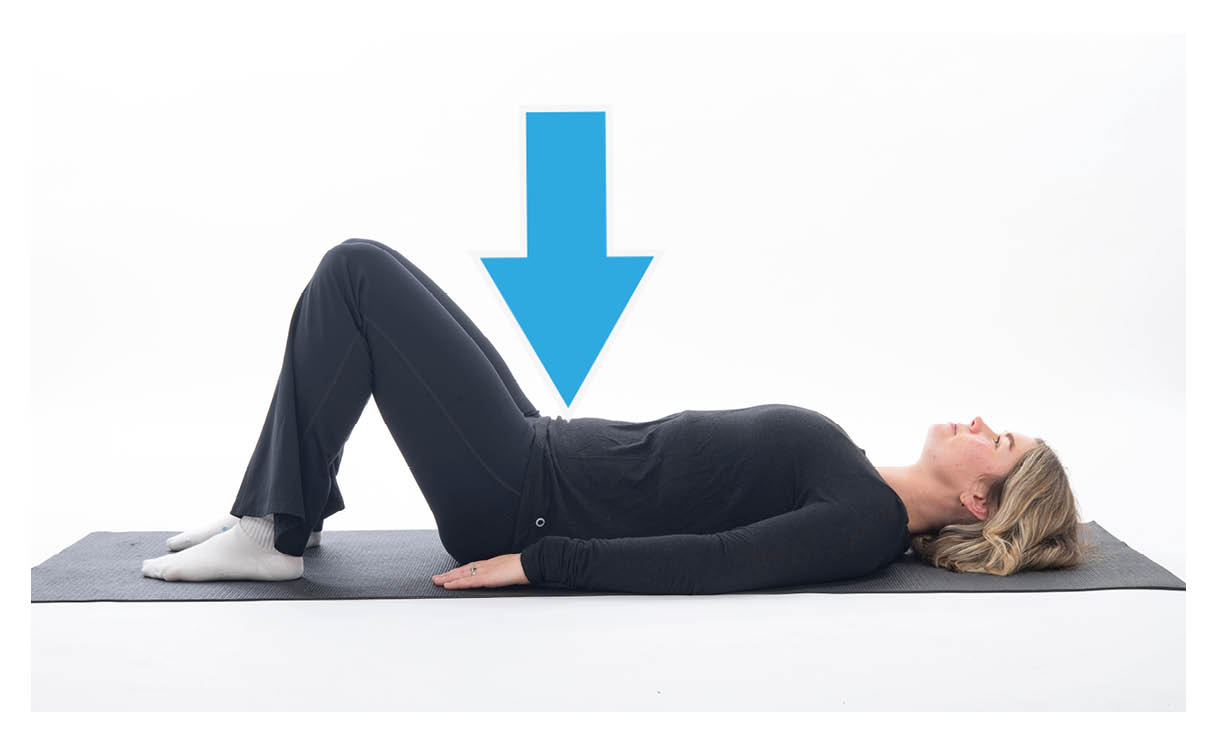 Basic abdominal contractions; As you breathe out gently, draw your belly button in towards your spine.
Basic abdominal contractions; As you breathe out gently, draw your belly button in towards your spine. -
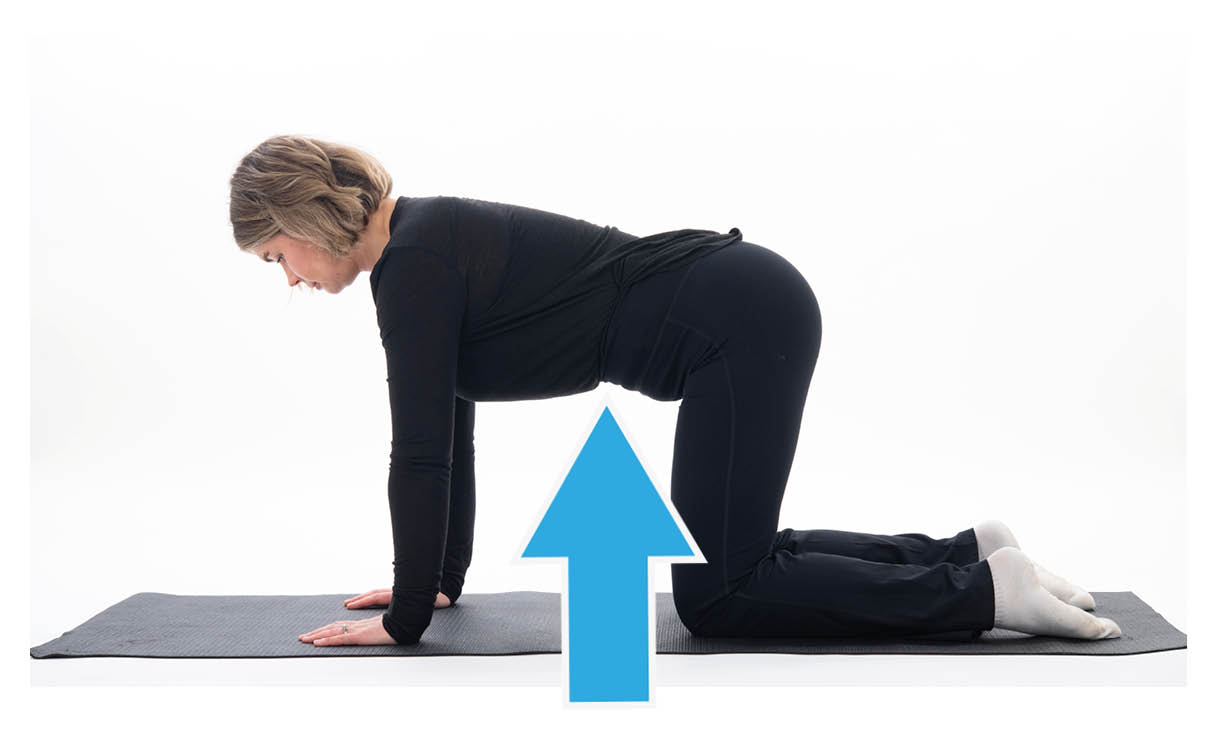 Basic abdominal contractions while kneeling
Basic abdominal contractions while kneeling
Do not worry if you find it difficult to contract your deep abdominal muscles, this is completely normal. Keep practicing. Ask your GP to refer you to physiotherapy if it does not feel easier after 3 weeks practice.
Gentle core exercises
Once you are comfortable doing the basic abdominal contractions, you can now move on to gentle core exercises.
Always make sure you are comfortable before you begin these exercises. To start with, repeat each of these exercises once a day, 5 times (or less, if needed). Build up slowly.
Reduce or stop the exercises if you feel pain. Try again a few days later.
Be aware of your tummy. Stop these exercises if you notice any ‘bulging out’ (doming) of your tummy when doing them. Instead return to the pelvic floor and basic abdominal exercises, before trying again after a week or so. If the bulging continues when you exercise, ask your GP to refer you to physiotherapy.
Pelvic tilt
Lie on your back with your knees bent and your feet flat on the floor / bed.
Breathe out. Engage your pelvic floor muscles while you flatten your back into the bed / floor.
Breathe in. Tilt your pelvis forward, and arch your back off the bed slightly. This should be a small movement.
Repeat 5 to 10 times slowly.
Your bottom should stay in contact with the floor / bed at all times.
-
-1741857281.jpg) Breathe out. Engage your pelvic floor muscles while you flatten your back into the bed / floor.
Breathe out. Engage your pelvic floor muscles while you flatten your back into the bed / floor. -
 Breathe in. Tilt your pelvis forward, and arch your back off the bed slightly. This should be a small movement.
Breathe in. Tilt your pelvis forward, and arch your back off the bed slightly. This should be a small movement.
Mini bridge
Lie on your back with your knees bent and your feet flat on the floor / bed.
Breathe out. Engage your pelvic floor muscles while you flatten your back into the bed / floor.
Push through your feet. Let your bottom and lower back lift away from the floor / bed. Keep your ribs lower than your hips. Start with a small lift and aim to lift higher as you get stronger.
Slowly lower your bottom and back down to the floor / bed.
Repeat 5 to 10 times slowly.
-
.jpg) Breathe out. Engage your pelvic floor muscles while you flatten your back into the bed / floor.
Breathe out. Engage your pelvic floor muscles while you flatten your back into the bed / floor. -
.jpg) Push through your feet. Let your bottom and lower back lift away from the floor / bed.
Push through your feet. Let your bottom and lower back lift away from the floor / bed.
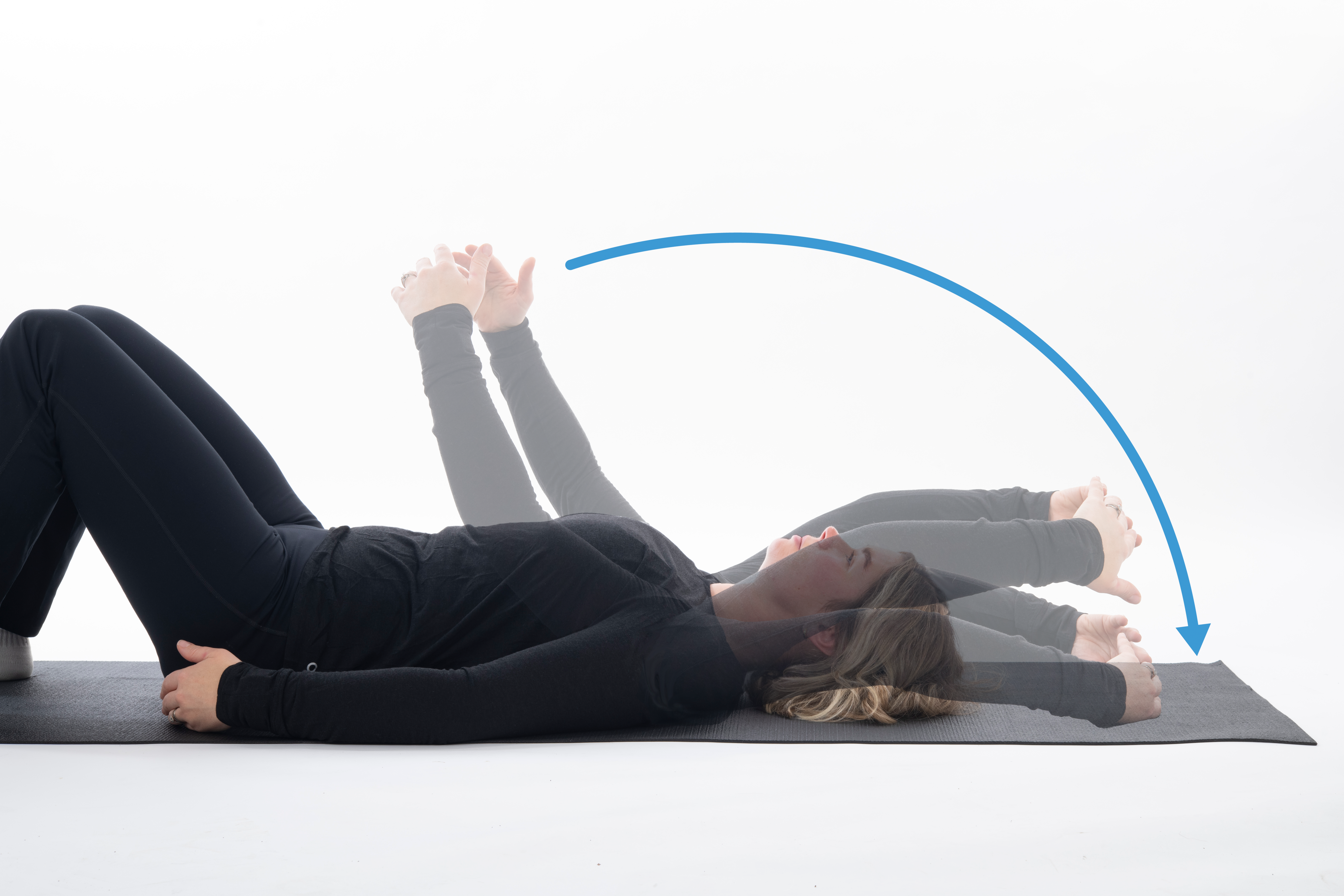
Arm lifts / circles
Lie on your back with your knees bent and your feet flat on the floor / bed.
Breathe out. Engage your pelvic floor muscles. Slowly let both arms lift up away from your sides, over your head.
Use your tummy muscles to keep your ribs pulled down and your back still. Do not arch your back.
Lower your arms slowly down by your sides again; or lower your arms sideways in a circle until they are next to your legs again.
Repeat 5 to 10 times slowly.
Your back should stay in contact with the floor / bed at all times.
.png)
One leg stretch
Lie on your back with your knees bent and your feet flat on the bed / floor.
Tighten your pelvic floor muscles. Slowly slide one leg away from you. Keep your heel on the bed / floor.
Breathe in and out. Keep your pelvic floor muscles tightened and slide your leg back up. Relax.
Repeat on the other side.
-1747312536.png)
Hip twist
Lie on your back with your knees bent and your feet flat on the bed / floor.
Tighten your pelvic floor muscles. Slowly let one leg draw out to the side, away from you. Keep your heel on the bed / floor.
Breathe in and out. Keep your pelvic floor muscles tightened and draw your leg back in. Relax.
Repeat on the other side.
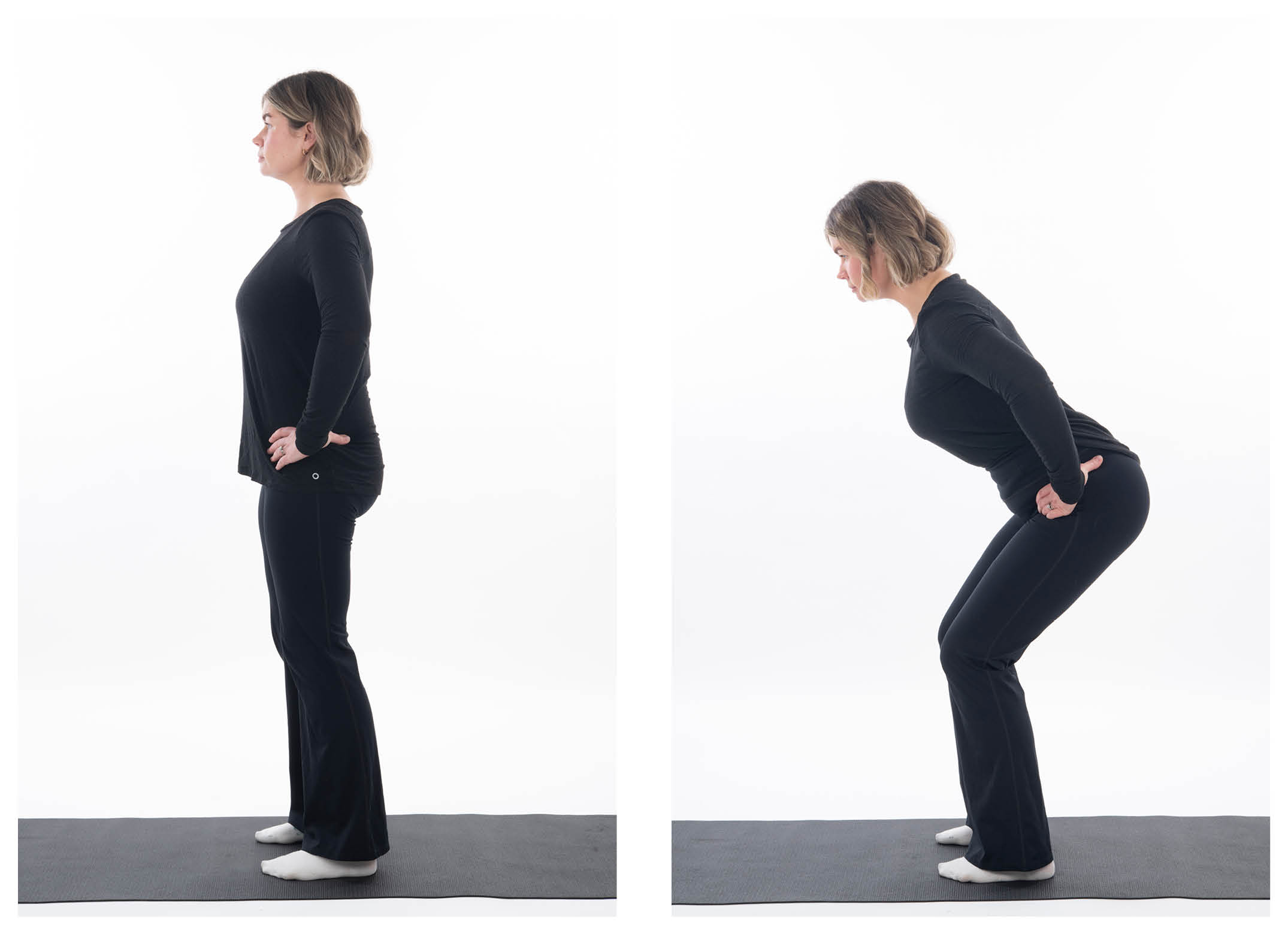
Mini squat
Stand with your feet flat on the floor, hip distance apart.
Bend at the knees and hips, and lower down into a mini squat. Keep your hips above knee height.
Engage your pelvic floor muscles, push through your feet and straighten your knees. Bring your hips forwards and up, back to standing again.
Repeat 5 to 10 times slowly.
.png)
Kneeling “thread the needle” stretch
Kneel with hands under your shoulders and your knees under hips. Relax your elbows, and bring your head in-line with the rest of your body.
Lift one hand up, following it with your eyes. Lift your arm and rotate your upper body with it. Keep your back and hips still.
Lower your hand to the floor, and repeat with your other hand / arm.
Repeat 5 to 10 times slowly.
Continue all these exercises until you have resumed your normal activities.
When can I resume my normal activities?
It is important to return to activities gradually. Make sure you start off slower than you normally would, for shorter periods of time. If your body feels okay, you can build up the amount of exercise you do. People recover at different rates. If you exercised regularly before your pregnancy you may be able to return to fitness more quickly.
Walking
You can start walking once you feel comfortable. It is an easy form of exercise, but it is important to build up slowly.
Pilates / Yoga
You can usually start mat-based exercise classes after 6 weeks. Classes specifically tailored for after pregnancy, may be the best option to start with. Make sure you do not have a tummy bulge when doing any of the exercises.
Practice pelvic floor and basic abdominal exercises first. Always tell your instructor that you have recently been pregnant.
East Kent Hospitals Physiotherapy Pilates Class for pregnancy and after birth. Take a look at our video. You can start this exercise 6 weeks after birth, if you feel able.
Swimming
Swimming can be started once you have had 7 days clear from vaginal bleeding / discharge. If you had a caesarean birth, you may need to wait until you have seen your GP at your 6 week check-up.
It is very easy to over-exercise in water. Start off gently, with a smaller amount of time than you think you can manage. Build up gradually.
Cycling
If you feel comfortable, you can start cycling after 6 weeks.
Other exercises
Do not consider more strenuous activities, such as jogging or gym classes, until after 12 weeks. Make sure you are confident doing pelvic floor and basic abdominal exercises first. If you decide to take an exercise class, make sure you tell your instructor that you have recently been pregnant.
Do not resume these activities if you have:
any leaking of wee, wind, or poo; or
a feeling of pressure / bulge / dragging in your vagina.
If you have any specific concerns, speak to a pelvic health physiotherapist first.
For more information, please read Your guide to return to running following childbirth.
Sex
Everyone is different, so you can start having sex again when you feel ready. It is normal to have a temporary lack of interest in sex. Remember to use a contraceptive, as it is very easy to fall pregnant soon after pregnancy.
Lifting and housework
Avoid strenuous housework until you are able to practice pelvic floor and basic abdominal exercises confidently, without a tummy bulge. Strenuous housework includes vacuuming, ironing, or cooking. Ask for help from friends and family to start with, and build up slowly.
Most importantly
Take your time as you return to your pre-pregnancy level of activity. Every woman is different and each experience of pregnancy is unique. Try not to compare yourself with others, listen to your own body.
It is important for you to recover emotionally, as well as physically. Exercise can help with this recovery. However, do not feel any pressure to do more than you feel ready to. If you need more help with your physical recovery, speak to your GP. They can refer you to a specialist physiotherapist for more advice on your recovery.
Useful contacts
If you need help or advice, please contact our Maternity telephone triage service on 01227 206737.
Further information
Pelvic Obstetric and Gynaecological Physiotherapy. Exercise and advice after pregnancy (2022).
Pelvic Obstetric and Gynaecological Physiotherapy. Pelvic floor exercises for women video.
What do you think of this leaflet?
We welcome feedback, whether positive or negative, as it helps us to improve our care and services.
If you would like to give us feedback about this leaflet, please fill in our short online survey. Either scan the QR code below, or use the web link. We do not record your personal information, unless you provide contact details and would like to talk to us some more.
If you would rather talk to someone instead of filling in a survey, please call the Patient Voice Team.
Patient Voice Team
Telephone: 01227 868605
Email